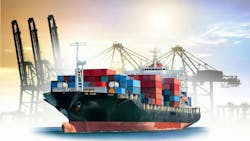Bridge Collapse and East Coast Transportation Update
Download this article in PDF format.
A coordinated effort to shift goods away from the Port of Baltimore has been in full force after the Francis Scott Key Bridge was hit by a large ocean vessel last month. The bridge collapsed, taking at least six lives with it. Within days, logistics, supply chain and transportation providers were scrambling to reroute cargo and divert goods that would otherwise be moving in and out of the Port of Baltimore on a daily basis.
The Port of Baltimore is among the top 20 ports in the U.S. by tonnage and number of containers handled, is the 10th largest port for dry bulk, and is a major hub for the import and export of motorized vehicles, according to the Bureau of Transportation Statistics.
The fallen bridge was also a key East Coast artery that carried 12.5 million vehicles in 2023, averaging more than 34,000 vehicles a day over the year. This is 15% of the total traffic for all three port crossings, and the diverted traffic is now contributing 18% to the combined volumes for the Fort McHenry and Harbor Tunnels.
What’s Happening Now
Right now, an extensive effort is underway to shift goods away from the bridge disaster, according to WSJ. “The effort to locate shipments, find new ports and patch together new transportation is part of a massive logistics undertaking in and around one of the U.S. East Coast’s biggest ports,” Liz Young writes.
“It takes in operators including major automakers around the world, local truckers, and railroads,” she continues, “as well as a range of exporters and importers trying to contain the impact of the latest disruption to hit global supply chains.”
So far, port officials have not estimated when they expect to reopen the shipping channel to vessels. Dun & Bradstreet estimates the weekly impact of the port closure on trade at about $1.7 billion, based on the value of consumer goods, automobiles, coal and other shipments that moved through the port on average each week in 2023, WSJ reports.
Feeling the Impacts
In “Supply Chain Chaos Threatens East Coast After Baltimore Bridge Collapse,” PYMNTS points out that “when supply chains run smoothly, the economies they support do too.” But when even the smallest disruption occurs, one event can set off a cascading impact down the entire logistics value chain.
“The impacts to the local region will be significant for several months or years until the bridge is rebuilt,” Lisa Anderson, founder and president of LMA Consulting Group, told PYMNTS. “Even once the port is reopened, trucks will continue to be re-routed around Baltimore, adding time and cost to trips from the port and through the Baltimore area.”
The U.S. Coast Guard has opened a temporary alternate channel for vessels that are helping with the cleanup effort. “The most critical timeframe is clearing the bay to reopen the port, which could take weeks,” Anderson added. “This will impact the ninth biggest port in the U.S. and 3,200 sites involved in logistics, distribution and warehousing nearby the port and bridge as well as local businesses.”
Logistics Headaches, but Not a Supply Chain Crisis
As insurance companies, carriers and transportation providers continue to assess the damage and aftermath of the bridge collapse, some experts are bullish on the East Coast’s ability to absorb the additional traffic in the interim.
In “Baltimore bridge collapse to cause logistics headaches, not supply chain crisis,” Reuters says the accident is causing “some logistics headaches, but is unlikely to trigger a major new U.S. supply chain crisis as competing East Coast ports are poised to handle more cargo.” It also says port officials from New York to Georgia were busy fielding queries from shippers about diverting Baltimore-bound cargo from containers to vehicles and bulk material.
"We're ready to help. We have ample capacity to absorb any surge in container traffic," Port of Virginia spokesperson Joe Harris told Reuters. The Norfolk-based port is expected to be a major beneficiary due to its proximity to Baltimore, but ports in Savannah and Brunswick, Ga. also were poised to absorb some traffic.
On April 2, the first commercial vessel to exit Baltimore's inner harbor after the collapse made it safely through a temporary channel set up by the Army Corps of Engineers. The Maritime Executive says that the channel will enable the movement of salvage vessels between the two sides of the bridge's wreckage.
About the Author
Avery Larkin
Contributing Editor
Avery Larkin is a freelance writer that covers trends in logistics, transportation and supply chain strategy. With a keen eye on emerging technologies and operational efficiencies, Larkin delivers practical insights for supply chain professionals navigating today’s evolving landscape.






